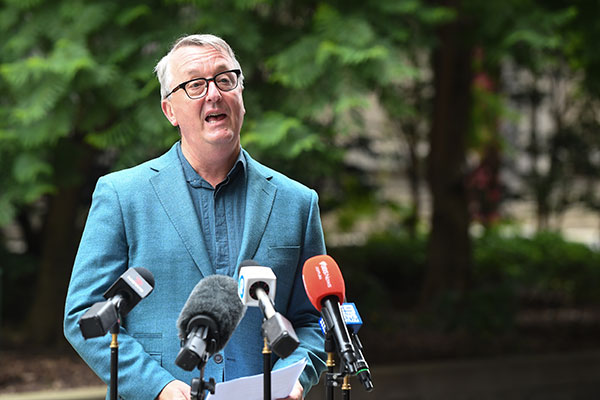Selected
- Details
- Written by Grant Broadcasters
- Category: Selected
- Hits: 119

Seven-day isolation for COVID-19 close contacts, compulsory masks for primary school students and the vaccine mandate for venues will be scrapped in Victoria.
A raft of restrictions will ease from 11.59pm on Friday after the state passed the peak of its second Omicron wave, Health Minister Martin Foley announced on Wednesday.
"We know that there will be a long plateauing and tail to this BA.2 Omicron sub-variant wave," he told reporters.
"But what we know is that we've passed the peak and we are able to look to this group of sensible measures being able to take us into a still-challenging winter."
Under the changes, close contacts of confirmed cases will no longer have to quarantine if they wear a mask indoors, avoid sensitive settings and return five negative rapid antigen tests over the seven-day period.
Similar changes have been unveiled by the NSW government.
Business groups have been calling for the seven-day isolation rule for household contacts to be relaxed to ease ongoing staff shortages.
Positive cases still need to self-isolate for the full seven-day period in Victoria and masks will remain mandatory on public transport, in airports and health, aged care and justice settings.
In addition, Victorians will no longer be required to have two vaccine doses or show their vaccination status before entering pubs, restaurants, movie theatres and sports venues.
Premier Daniel Andrews previously said the state's vaccinated economy could remain in place until 2023.
COVID-19 vaccine mandates for key industries such as healthcare, food distribution, police, emergency services and education will remain.
The state's new pandemic-specific legislation shifted the power for changing COVID-19 restrictions from Chief Health Officer Brett Sutton to Mr Foley.
Professor Sutton said health policy was transitioning to individual discretion, given the level of vaccination coverage in the community.
"We've got enough in-built protection as a community that further restrictions are not proportionate or necessary," he said.
Victoria's seven-day case average remains below 10,000, despite the state recording 10,628 new COVID-19 cases and 14 deaths on Wednesday.
Prof Sutton said he believed the wave had plateaued, with daily infections falling 10 per cent over the past week.
"I think today's a blip. It's going to be a long tail and slow decline. We're not going to see a dramatic drop in numbers," he said.
Prime Minister Scott Morrison welcomed the changes.
"In NSW and Victoria they are getting back to normal - hallelujah," he said.
© AAP 2022
Photo: Victorian Health Minister Martin Foley in 2021. (AAP Image/Erik Anderson)
- Details
- Written by Grant Broadcasters
- Category: Selected
- Hits: 118

Stroke survivors who participated in an online, interactive program suggesting healthy lifestyle options are showing improved health outcomes.
Researchers found stroke survivors using the online service urging them to set health goals and monitor their own progress, reported a 'higher health-related quality' of life after six months, compared to a control group who were given only generic health information.
The study, conducted by the University of Newcastle and Flinders University, concluded the findings demonstrated the strength of web-based programs in treating people who had suffered a stroke.
"Online platforms are a viable and impactful model to address the health information needs and behaviour change challenges of stroke survivors," study lead Ashleigh Guillaumier said.
Senior author Billie Bonevski said the program's effectiveness was a culmination of eight years of research and they now plan to scale up their Prevent 2nd Stroke program so it can benefit more stroke survivors.
People who suffer and survive stroke can go on to have serious physical and cognitive disabilities.
However, improving various lifestyle factors can improve stroke sufferers' quality of life, including cutting tobacco and alcohol use and improving diet and exercise.
The P2S program encourages users to set health goals and monitor their own progress.
The randomised control trial involved some 339 stroke survivors being either placed on the P2S online program for 12 weeks, or being randomly assigned a list of generic health websites.
People assigned to P2S were also sent text prompts urging them to continue using the program.
In a follow up survey six months on, researchers found those who used P2S had a higher health-related quality of life score than those given generic health information.
A significantly higher proportion of the group using P2S also said they had no problems with going about daily activities and personal care.
The scope of the study was limited by all participants being considered "well" stroke survivors, and having little to no disability within the cohort, Dr Guillaumier and Prof Bonevski said.
The study was published in journal PLOS Medicine on Wednesday, and funded in part by the National Health and Medical Research Council and the National Heart Foundation.
© AAP 2022
Image: Cottonbro / Pexels
- Details
- Written by NSW News
- Category: Selected
- Hits: 136

NSW Health is today reporting the deaths of eight people with COVID-19 - five women and three men.
One person was aged in their 60s, two were aged in their 70s, three were aged in their 80s and two were aged in their 90s.
One person was unvaccinated.
Three were from Sydney’s south, one was from Western Sydney, one was from Sydney’s south west, one was from Sydney’s north, one was from the Lake Macquarie area and one was from the Northern Rivers.
This brings the total number of COVID-19 related deaths in NSW since the beginning of the pandemic to 2,626.
There are currently 1623 COVID-19 cases admitted to hospital, including 70 people in intensive care, 21 of whom require ventilation.
There were 10,856 positive test results notified in the 24 hours to 4pm yesterday.
They included 1449 cases from the Hunter New England area, 1081 from South Western Sydney, 612 from the Illawarra Shoalhaven Local Health District and 299 from Southern NSW.
- Details
- Written by Grant Broadcasters
- Category: Selected
- Hits: 122

Male lyrebirds that are looking for love can use their mimicry to "compose" songs to serenade females during the breeding season.
Research led by Western Sydney University found the ground-dwelling birds that are renowned for their ability to mimic can also "compose" songs from the sounds they hear in their environment.
Lead researcher PhD student Fiona Backhouse says lyrebirds are a bit like hip-hop artists, using sounds produced by other birds to compose new songs by assembling them into sequences.
Many bird species organise their songs into sequences, yet little is known about the drivers of that sequence structure, including with lyrebird mimicry.
"We've established that each population has a characteristic song sequence, where individual males sing the same song sequence many times during the breeding season with only minor variations," she said.
"His neighbours will sing a very similar song sequence, but there are differences among populations," Ms Backhouse said.
On average, the study found the similarity between sequences an individual male sings was 40.7 per cent - a figure significantly higher than expected by random chance.
The study found that lyrebirds copied sequences from their neighbours - who also copied sequences from others.
"This then provides the ingredients for a 'game of telephone', whereby changes in sequence structure evolve throughout the species' range," the study said.
"This process is similar to how geographical differences arise in human communication."
Songs were sung with a high acoustic contrast, suggesting that sequence structure was a means to enhance perceptions of the male lyrebirds' repertoire.
"Lyrebirds appear to compose their song sequences to maximise drama ... so that consecutive samples are as dramatically different as possible.
"This seems like an excellent way to give the listener the best and quickest impression of the virtuosity of the male's mimicry."
Previously, lyrebirds and other vocal mimics were viewed as 'passive' mimics - like a recorder merely reproducing what they heard.
"This research shows that lyrebirds do in fact use their mimicry to 'compose' long, complex songs, all in an effort to appeal to their female listeners."
The study of male Albert's lyrebirds in Bundjalung Country, in eastern Australia was published in Proceedings of the Royal Society B: Biological Sciences.
© AAP 2022
Image: www.environment.nsw.gov.au
Page 54 of 191